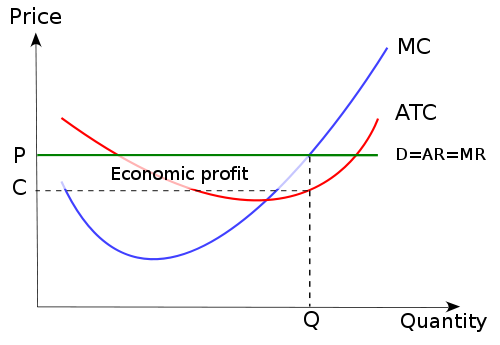Difference Between Perfect Competition and Monopolistic Competition
Perfect and monopolistic competitions are forms of market structure that determine the level of competitiveness between companies in a specific region.

What is Perfect Competition?
The term perfect competition is used to describe a market scenario where there are a large number of seller and buyers who are selling and buying similar goods and services.
Since the products and services bought or sold in this market scenario, there are no barriers to entry or exit and the prices are almost identical.
It is difficult to have a market with the characteristics that demonstrate a perfect competition, but the scenario is used to help understand other market structures, which include monopolistic or oligopolistic competitions.
What is Monopolistic Competition?
Monopolistic competition is used to explain a scenario where there are a large number of buyers of a specific product but a very few number of sellers of the same product.
A dominant seller controls prices, quality, and quantity of products or services in monopolistic competition.

Difference Between Perfect Competition and Monopolistic Competition
Price Determination for Perfect and Monopolistic Competition
In perfect competition, the forces of demand and supply determine the prices of goods and services. This means that all the firms in that market sell the products at that price.
The prices of goods and services in a monopolistic competition are determined by the enterprises in that market. Each company sells products at its prices.
However, the dominant company in a monopolistic competition has a ripple effect whereby it can determine the prices of goods and services in that market.
Product Standardization in Perfect and Monopolistic Competition
Product and service standardization characterize perfect competition. This means that all the products in that market have similar characteristics and are produced using the same technology.
On the other hand, goods and services offered in the monopolistic competition are not standardized. The products and services provided do not have similar features and are not produced using the same technology.
Consumers use the different features of the products and services to determine which goods to purchase owing to taste and preferences.
Number of Sellers and Buyers in Perfect and Monopolistic Competition
A large number of sellers producing similar goods and services characterize the market structure in perfect competition. Additionally, perfect competition has a large number of buyers buying the products produced by the companies.
Numerous sellers who sell close substitute goods and services to the buyers characterize a monopolistic competition. A dominant producer dominates regarding products produced and price determination in monopolistic competition.
Selling Costs of Perfect and Monopolistic Competition
In monopolistic competition, all the companies in the market structure produce different products and services, which mean that each firm bears the costs of selling and marketing the products. Each group has to advertise its distinct products or services.
Perfect competition is characterized by similar goods and services, which are sold at uniform prices. Moreover, the selling costs are less because the firms in the industry share the costs of advertising the goods and services on offer.
Average Revenue and Marginal Revenue for Perfect and Monopolistic Competition
Average revenue (AR) and marginal revenue (MR) are equal in perfect competition. This means that, when the curves are plotted on a graph, the average revenue curve coincides with the marginal revenue curve.
AR = MR
In monopolistic scenario, the average revenue (AR) is higher than the marginal revenue (MR) in a monopolistic competition because any firm willing to increase its sales must lower down the prices of its goods and services.
AR > MR
Slope of Demand Curve
The slope of the demand curve in perfect competition is horizontal, which shows perfect elastic demand. This means that a little change in prices of goods and services leads to an infinite change in the number of products or services demanded.
The slope of the demand curve in a monopolistic show a downward trajectory, which is a representation of elastic demand. This means that changes in prices lead to relatively significant changes in quantity.
Barriers to Entry and Exit
Any company willing to enter and exit a perfect competition can do so with without difficulties. This is the reason why a perfect competition has many businesses leaving and joining in a market characterized by perfect competitions.
The entry and exit in monopolistic competition is a difficult task. New companies fear to enter such markets because there is an already existing dominant enterprise. Additionally, dominating corporations find it difficult to leave such markets because of the profits they are enjoying.
Difference Between Perfect Competition and Monopolistic Competition: Comparison Table

Summary of Perfect Competition vs. Monopolistic Competition
- Perfect and monopolistic competitions are market scenarios that describe the level of competition in a specific geographical region.
- Perfect competition describes a market structure where many sellers are selling similar goods and services and many buyers buying related products and services.
- Numerous sellers selling goods and services to buyers characterize a monopolistic competition. However, a dominant seller is controlling the market regarding prices and quality of products.
- Other differences between perfect and monopolistic competition include the barriers to entry and exit, the slope of the demand curve, average revenue and marginal revenue, product standardization, and price determination among others.
- Difference Between Gross NPA and Net NPA - April 20, 2018
- Difference Between Job Description and Job Specification - April 13, 2018
- Difference Between Yoga and Power Yoga - April 10, 2018
Search DifferenceBetween.net :
Leave a Response
References :
[0]Finn, Mary G. "Perfect competition and the effects of energy price increases on economic activity." Journal of Money, Credit, and banking (2000): 400-416.
[1]Helpman, Elhanan. "International trade in the presence of product differentiation, economies of scale and monopolistic competition: a Chamberlin-Heckscher-Ohlin approach." Journal of international economics 11.3 (1981): 305-340.
[2]Shaikh, Anwar. "Marxian competition versus perfect competition: further comments on the so-called choice of technique." Cambridge Journal of Economics 4.1 (1980): 75-83.
[3]Image credit: https://upload.wikimedia.org/wikipedia/commons/thumb/5/52/Imperfect_competition_in_the_short_run.svg/640px-Imperfect_competition_in_the_short_run.svg.png
[4]Image credit: https://commons.wikimedia.org/wiki/File:Perfect_competition_in_the_short_run_(simple).svg#/media/File:Perfect_competition_in_the_short_run_(simple).svg
